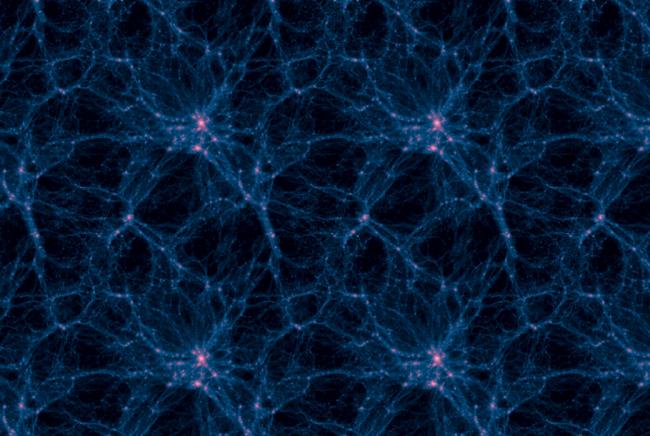Theoretical Astrophysics
Understanding the cosmos involves both observation and theory. Observation provides real-world data about how stars, galaxies, and other objects in space behave. Theory connects that data together into a full understanding, and makes predictions about phenomena we haven’t observed yet. Theoretical astrophysics includes mathematical models for astronomical systems, along with templates to fit to new results when they arise.
Our Work
Center for Astrophysics | Harvard & Smithsonian theoretical astrophysicists study a wide range of phenomena:
-
Building models of star-formation based on observation and theory. Using the data from star-forming regions and theoretical calculations of gas and dust under the action of gravity, astrophysicists have concluded stars tend to be born in pairs. Those binaries may be disrupted later, as happened with our Sun, but the theory suggests there’s a twin Sun somewhere out there.
New Evidence That All Stars Are Born in Pairs -
Calculating the potential conditions on exoplanets orbiting a variety of stars. Astronomers have discovered a number of planets orbiting red dwarf stars, which are much lower temperature than the Sun. That means potentially habitable worlds in these systems are very close to the star, possibly too close. Calculations show that these exoplanets may be uninhabitable based on magnetic activity and solar wind.
More to Life Than the Habitable Zone -
Determining the nature of inflation, the extraordinarily rapid expansion of the cosmos that many cosmologists think occurred when the universe was just a split-second old. Inflation explains many aspects of the universe we see today, but we have no direct evidence for it. Early-universe researchers examine the different possible ways inflation could have worked, including potential observable effects.
Theorists Propose a New Method to Probe the Beginning of the Universe
Modelling the Cosmos
Theory is the way scientists connect facts into a coherent system of thinking, which they can use to understand the natural world. The most powerful theories both explain what we observe in a coherent way and predict new phenomena, providing us with deep insights into how the universe works.
Science needs both theory and data collected through observation or experiment. Theory produces a mathematical description or model of certain systems, which generalizes data taken from particular observations to explain them and others. In that way, observations are the test of theory, and theory is the explanation for observations. Sometimes theory predicts new phenomena that are later observed, such as gravitational waves, which were first described in 1916, but only detected a century later. In other instances, astronomers observe phenomena for which theorists don’t have an explanation, such as the accelerating expansion of the universe.
Theoretical astrophysics covers as wide a range of topics as observational astronomy.
-
Star- and planet-formation models indicate that stars and planets are born from dense, cold clouds of gas and dust, which we describe by modeling the way matter collapses under its own gravity when compressed. Today, researchers model star and planet formation using computers, to understand the details of the magnetic fields of the newborn stars, the way planets migrate within the protoplanetary environment, and other details. [ link to “star” and “planet formation” pages ]
-
We only know of one planet where life exists, but with thousands of known exoplanets and billions more likely in the Milky Way alone, researchers want to know how possible life is elsewhere. Theoretical models help constrain the possibilities, based on the environments for exoplanets we observe.
-
Calculating gravitational interactions between three or more objects is still a challenging problem. Astrophysicists use advanced mathematics and computer simulations to model star clusters, multi-planet or -moon systems, and many more.
-
Theory is necessary for cosmology — the study of the whole universe — for two major reasons. First, there are hundreds of billions of galaxies and countless stars, but only one universe, so we don’t have any way to compare the possibilities if things are slightly different. Second, matter in the early universe was dense and opaque, so it is inaccessible to observations. Theory fills in those gaps, testing ways the universe could have evolved differently, and finding the physical conditions that produce the cosmos we observe. These models help us understand dark matter, dark energy, and other phenomena we observe, but which we don’t have a good explanation for yet.
-
For much of astrophysics, Newton’s theory of gravity is perfectly adequate to predict how things behave. However, in instances of strong gravity or very large scales, astrophysicists use Albert Einstein’s theory of general relativity. Those cases include black holes, neutron stars, gravitational waves, and the structure of the universe as a whole.

Simulation using the Illustris program of the dark matter governing the distribution of galaxies. Such simulations connect astronomical observations of galaxies to the theory describing how the universe evolves.
- What conditions are necessary for life?
- Does life exist outside of the solar system?
- How do stars and planets form and evolve?
- What happened in the early universe?
- Solar-Stellar Connections
- Minor Planets and Comets
- Moons and Satellites
- Neutron Stars and White Dwarfs
- Planetary Atmospheres
- Solar and Stellar Atmospheres
- Solar System
- Star Clusters
- Stellar Structure and Evolution
- Supernovas & Remnants
- Variable Stars and Binaries
- Black Holes
- Cosmic Microwave Background
- Dark Energy and Dark Matter
- Disks
- Early Universe
- Elemental Abundances
- Exoplanets
- Gravitational Dynamics
- Intergalactic Medium
- Jets, Outflows and Shocks
- Large Scale Structure